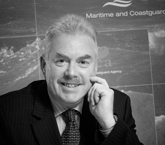 Tuesday 18 Dec. 2012 – lloyds.com talks to Hugh Shaw*, the UK’s Secretary of States Representative for Maritime Salvage and Intervention (SOSREP) about keeping our seas safe and clean, and the complexities of removing ship wrecks from our waters.
Tuesday 18 Dec. 2012 – lloyds.com talks to Hugh Shaw*, the UK’s Secretary of States Representative for Maritime Salvage and Intervention (SOSREP) about keeping our seas safe and clean, and the complexities of removing ship wrecks from our waters.
Briefly describe your responsibilities?
The role of the SOSREP was created in 1999 as part of the Government’s response to Lord Donaldson’s Review of Salvage and Intervention and their command and control. On behalf of the Secretary of State, I’m able to oversee, control and, if necessary, to intervene and exercise “ultimate command and control” acting in the over-riding interest of the UK in maritime casualty operations in UK jurisdictional waters involving ships or fixed platforms, including wrecks.
There has been a number of high profile wrecks recently, why have wreck removal operations increased in complexity?
Ship type, size, location and the nature of the hazard will determine the complexity of the operation. New technology, such as the use of Remotely Operated Vehicles (ROVs) for sub-surface bunker removal has enhanced the salvors’ capability to remove safely more hazards than would have been possible a number of years ago.
Media interest and public expectation over environmental concerns can add to the complexity.
Is it always necessary to remove a wreck?
No. The State will seek removal if it determines the wreck to be a hazard. The definition of hazard is extremely broad and covers threats to navigation as well as harmful consequences to the marine environment, coastline or related interests. It is however worth noting that “wreck” can include any object that is lost at sea from a ship such as containers.
How much influence do shore based authorities have to determine the method used for a wreck removal?
The shore based authorities have a responsibility to ensure that any salvor appointed has the capability and experience to carry out the operation. The State also needs to ensure that any safety and environmental concerns are reflected in the methodology and that the proposed plan is in the best interests of the State. Certainly within the UK if the SOSREP is not satisfied that the salvor has the relevant capability then he will persuade, or direct, the owners or insurers of the casualty to engage alternative or additional salvors or to modify their proposed plan.
Do shore based authorities consider the costs and insurance implications in assessing the best course of action?
With the exception of approving the methodology, the coastal States will not normally be aware of the financial costs agreed between the salvor and the insurers. The role of the coastal State is to ensure that the salvor and plan are both fit for purpose and that the best course of action addresses the hazards caused as a result of the accident.
Are you concerned about the rising cost of wreck removal?
I would be more concerned if there were no funds available to pay for the operation. The Convention will impose strict liability on the registered owner of the ship for the costs of locating, marking and removing the wreck and will apply to all ships of 300 gross tonnage and above, and will require registered owners to maintain insurance to cover their liabilities.
What difference will the Nairobi wreck removal Convention make when it is ratified by the requisite number of states?
The Convention will fill a gap in the existing international liability framework by providing the first set of uniform international rules aimed at clarifying the rights and obligations regarding the identification, reporting, locating and removal of hazardous wrecks internationally. The Convention also contains provisions which will assist a State Party in recovering from the shipowner the costs associated with removal of a wreck.
Does concern for the environment govern all aspects of the job?
No. Obviously protection of the environment is paramount but ‘hazard’ includes threats to public health and risk to safety and these areas will always take precedence.
What are your concerns about availability of contractor expertise and heavy equipment?
Container ships with 16, 000 + TEU capacity are now in operation around the world. The salvage and insurance industry need to ensure that the expertise and specialised equipment is in place to deal with these mega-ships should an accident occur. The timescales and costs in dealing with the MSC NAPOLI and MSC RENA are there for all to see. If the industry is concerned about the rising cost of wreck removal then perhaps now is the time for it to be more proactive and to ensure that a robust response capability is in place.
*Hugh Shaw is the UK’s Secretary of States Representative for Maritime Salvage and Intervention (SOSREP). He represents the Secretaries of State for the Department for Transport (in relation to ships) and for the Department of Energy and Climate Change (in relations to offshore installations).
He is responsible for removing or reducing the risk to safety, property and the environment arising from accidents involving ships, fixed or floating platforms or sub-sea infrastructure.
His powers extend to UK territorial waters (12 nautical miles from the coast/baseline) for safety issues and to the UK Pollution Control Zone (200 miles or the median line with neighbouring states) for pollution.
(Source: lloyds.com)





